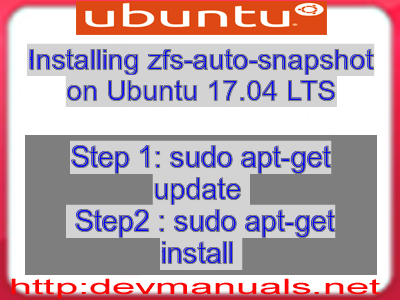Ads
Quick installation of :
Step 1: Update system:
sudo apt-get update
Step 2: Install:
Ater updaing the OS run following command to install the packae:
sudo apt-get install
Package Details | |
| Package: | |
| Version: | |
| Maintainer: | |
| Home page: | |
| Description: | |
| Distro: | Ubuntu 17.04 |
| Release: | |
| Repo/Section: | |
How to install on Ubuntu 17.04?

First of all update your system with the command:
sudo apt-get update
Ads
Above command will download the package lists for Ubuntu 17.04 on your system. This will update the list of newest versions of packages and its dependencies on your system.
After downloading the latest package list with the help of above you can run the installation process.
If is not installed on your compter then the command 'dpkg -L ' will give followin error.
deepak@deepak-VirtualBox:~$ dpkg -L zfs-auto-snapshot dpkg-query: package 'zfs-auto-snapshot' is not installed Use dpkg --info (= dpkg-deb --info) to examine archive files, and dpkg --contents (= dpkg-deb --contents) to list their contents. deepak@deepak-VirtualBox:~$
Installing :
After system update use the following command to install :
sudo apt-get install
Above command will confirm before installing the package on your Ubuntu 17.04 Operating System. If you are not already logged in as su, installer will ask you the root password. After completion of the installation you can use the package on your system.
How to uninstall/remove from Ubuntu 17.04?
Now we will see the commands for uninstalling the from Ubuntu 17.04. For uninstalling this package you can easily use the apt command and remove the package from Linux Operating System.
To remove the following command is used:
sudo apt-get remove
Following command is used to remove the package along with its dependencies:
sudo apt-get remove --auto-remove
This will remove and all its dependent packages which is no longer needed in the system.
Completely removing with all configuration files:
Following command should be used with care as it deletes all the configuration files and data:
sudo apt-get purge
or you can use following command also:
sudo apt-get purge --auto-remove
Above command will remove all the configuration files and data associated with package. You can can't recover the delete data, so, use this command with care.